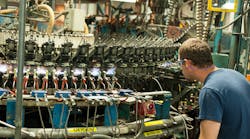For years, General Electric has used an electronic switch of its own design to control the circuits inside thousands of imaging machines it sells to hospitals. Now those switches are going on sale.
Last week, the industrial conglomerate said that it had spun out a company to sell the parts in new markets, ranging from electric vehicle chargers to cellular equipment. The start-up, Menlo Micro, based in Irvine, Calif., also said that it raised $18.7 million in funding from investors.
Menlo Micro is the latest of several companies that claim to have reinvented the electronic switch, a primordial part of electronics that controls the flow of electricity in a circuit. Their switch is both an ancestor of the mechanical light switch invented over a century ago and a relative of the tiny switches inside semiconductors.
The start-up’s switches are made of micro-electromechanical systems, or MEMS, which are like microscopic cotton gins with interlocking parts. They can be scaled to handle kilowatts of power like mechanical switches, while having the speed and reliability of semiconductor devices, said Russ Garcia, Menlo’s chief executive, in an interview.
The switch operates with low resistance and low losses, making it better than electromechanical devices at reducing heat and enduring billions of switch cycles. Menlo’s switches can be programmed digitally and could be used in relays that automatically control smart household devices, light bulbs, and heating systems in buildings.
“It is very close to an ideal switch,” Garcia said. The company said in a briefing last week that Tesla, Nest, and Honeywell are target customers.
Menlo Micro’s timing is also an advantage. General Electric and rivals like Rockwell Automation are increasingly using software and sensors to make smarter factory and medical devices. The new switches can remotely control a circuit breaker in electric vehicle chargers or factory robots, which need hundreds of volts to be turned on.
Menlo Micro’s technology centers on a metal alloy that the company is keeping under wraps. Many of the patents were devised by Chris Keimel, the co-founder of Menlo Micro and its chief technology officer, while he worked on circuit breakers in GE’s research and development division.
The work sprouted from not being able to find an extremely reliable MEMS switch, which Garcia said were the only devices that could handle the large power demands in industrial devices. GE engineers tested parts from multiple suppliers but kept on finding failure points.
“That brought about this thought – if we can’t buy it we’re going to make it,” Garcia said.
What the engineers learned about switch failures paid off. Menlo Micro’s devices have longer lifetimes than mechanical switches, which wear down over time and after operating outside normal conditions. Though semiconductor devices have longer life spans, the new switches last for billions of switch cycles without degrading.
The switches can be scaled to handle hundreds of volts while being small and efficient. A single switch can run on a billionth of an amp, the company said. To handle these higher voltages, Menlo was forced to make some slight sacrifices. Their switch flips circuits in the microsecond range, as opposed to the nanosecond switching of semiconductors.
The tradeoffs have not deterred investors. Paladin Capital Group, Corning, and Microsemi chipped into the $18.7 million funding round with GE Ventures. The start-up is using Corning’s glass materials to improve the heat tolerance of its switch.
Menlo Micro is starting out with one product, the MM3300, a MEMS switch for military radios and other wireless applications. It might also be used in tunable filters that block signals straying into the power amplifiers inside smartphones. Garcia said that the company would license out technologies destined for smartphones.
The company is bound to have some competition. Cavendish Kinetics, a start-up that makes MEMS switches for radio frequency applications, has raised over $68 million in funding and claims to have built devices that last for 100 billion switch cycles. Paul Del Santo, the company’s chief executive, expects to sell over 10 million parts this year.
Garcia, a former vice president at Microsemi, said that the company has already proved its reliability of its switches in harsh industrial environments.
“We already have proof of this,” he said. “We have tens of thousands of pieces already out in the market because GE has been using them in its M.R.I. platform. And that has some of the more rigorous specs in the industry.”
Correction: December 15, 2016. An earlier version of this article was unclear about the power handling capability of a new switch developed inside General Electric and sold by a new venture called Menlo Micro. The switch can be scaled to handle different power ratings, up to hundreds of volts. An individual switching element is not enough to handle hundred of volts.
